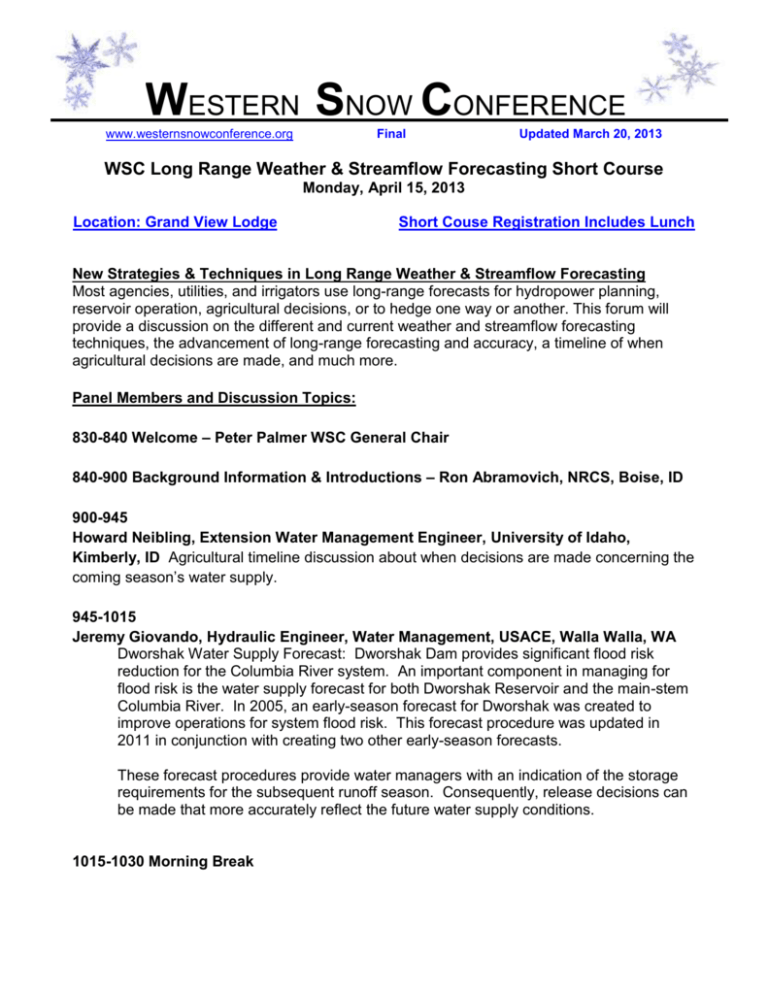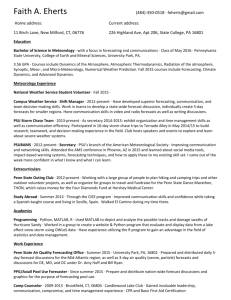Word - Western Snow Conference
advertisement

WESTERN SNOW CONFERENCE www.westernsnowconference.org Final Updated March 20, 2013 WSC Long Range Weather & Streamflow Forecasting Short Course Monday, April 15, 2013 Location: Grand View Lodge Short Couse Registration Includes Lunch New Strategies & Techniques in Long Range Weather & Streamflow Forecasting Most agencies, utilities, and irrigators use long-range forecasts for hydropower planning, reservoir operation, agricultural decisions, or to hedge one way or another. This forum will provide a discussion on the different and current weather and streamflow forecasting techniques, the advancement of long-range forecasting and accuracy, a timeline of when agricultural decisions are made, and much more. Panel Members and Discussion Topics: 830-840 Welcome – Peter Palmer WSC General Chair 840-900 Background Information & Introductions – Ron Abramovich, NRCS, Boise, ID 900-945 Howard Neibling, Extension Water Management Engineer, University of Idaho, Kimberly, ID Agricultural timeline discussion about when decisions are made concerning the coming season’s water supply. 945-1015 Jeremy Giovando, Hydraulic Engineer, Water Management, USACE, Walla Walla, WA Dworshak Water Supply Forecast: Dworshak Dam provides significant flood risk reduction for the Columbia River system. An important component in managing for flood risk is the water supply forecast for both Dworshak Reservoir and the main-stem Columbia River. In 2005, an early-season forecast for Dworshak was created to improve operations for system flood risk. This forecast procedure was updated in 2011 in conjunction with creating two other early-season forecasts. These forecast procedures provide water managers with an indication of the storage requirements for the subsequent runoff season. Consequently, release decisions can be made that more accurately reflect the future water supply conditions. 1015-1030 Morning Break 1030-1115 Jan Curtis, Meteorologist, NRCS, NWCC, Portland, OR Atmospheric indexes such as the Arctic Oscillation (AO), the Pacific North America (PNA), and North Atlantic Oscillation (NAO) are just as important as their more famous cousin, the El Nino Southern Oscillation (ENSO) in assisting forecasters with long range forecasting. How these weather / ocean patterns work and interact is the key to better forecasts. 1115-1200 Klaus Wolter, University of Colorado- CIRES, NOAA-ESRL, Boulder, CO Long range forecasting techniques 1200-100 Lunch on site included with Registration Lunch Speaker - Tony Willardson, Executive Director, Western States Water Council 100-200 Mel Kunkel, HydroMeteorologist, Idaho Power, Boise, ID The discussion will focus on two different/unique long-term forecasting techniques. One technique is based upon a multivariate regression technique that provides annual and quarterly natural flow forecasts up to 12 months ahead of time utilizing teleconnections data (i.e. ENSO, PDO) developed at BSU during Dr. Kunkel's PhD work. The second method was developed at the Universities of Tennessee and Idaho and utilizes Singular Value Decomposition (SVD) to select historic Sea Surface Temperature and/or 500 Mb regions for use in a non-linear forecasting model to forecast April 1st SWE values and seasonal precipitation values up to 12 month ahead of time. http://earth.boisestate.edu/people/graduate-students/mel-kunkel/ 200-230 Q&A Session with the Panel 230-300 Afternoon Break 300-500 WSC Executive Meeting Grand View Lodge 530- Registration & Ice Breaker Session in WSC Chairman’s Suite Panel Members Background Information: Background: Jeremy Giovando Jeremy has a B.S. in Environmental Engineering from Northern Arizona University and a M.S. in Civil Engineering from Colorado State University. He has worked in water management for 10 years for both the Bureau of Reclamation in Montana and the Corps of Engineers in Washington. His experience includes real-time water management of multipurpose hydropower facilities, water supply forecast development and reservoir modeling studies. Background: Mel Kunkel Background: Mel has over 20 years of operational weather and stream flow forecasting in many regions around the world from 20+ years in the Air Force. During his time in the Air Force he received an AS degree in Weather Technology. Since then he has received a BS degree in Hydrology from Boise State University, additionally he is currently finishing a PhD in Hydrology from Boise State. Background: Jan Curtis Jan Curtis received his BS Degree in Meteorology from the City University of New York (1974) and his MS Degree in Air-Ocean Sciences at the Naval Post Graduate School in Monterey, California (1989). During the first half of his professional life, he served as a career Naval Officer (meteorologist and physical oceanographer) where he provided weather and oceanographic forecasts and warnings. In 1995, Jan started his 2nd career by working at the Alaska Climate Research Center in Fairbanks where he co-authored several Journal Papers on climate and climate changes over Alaska and became famous for his aurora borealis photos. In 2001, he was appointed Wyoming’s State Climatologist during one of the state’s worst drought on record and forged a strong working relation with the National Drought Mitigation Center in Lincoln, Nebraska. In 2006, Jan moved to the Federal Government and began work for Natural Resources Conservation Service as an applied climatologist and meteorologist at the National Water & Climate Center in Portland, Oregon. He serves on the Executive Board of the American Association of State Climatologists. He is also the Program Manager for the development of spatial climatology products known as PRISM; working with Oregon State University and the PRISM Group headed by Dr. Chris Daly. In his spare time, Jan is the Multnomah County Coordinator for CoCoRaHS in Oregon. For more information contact: Ron Abramovich at Ron.Abramovich@id.usda.gov 208-378-5741







